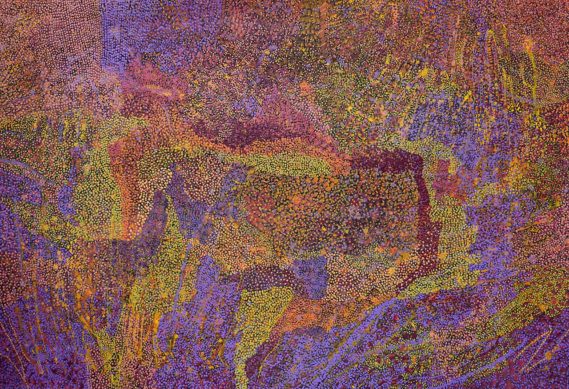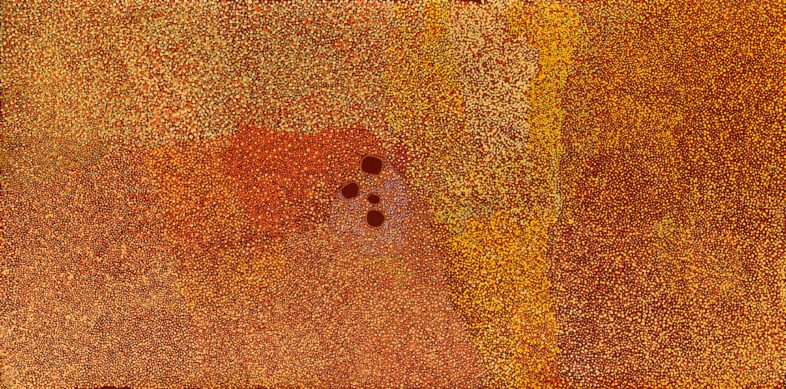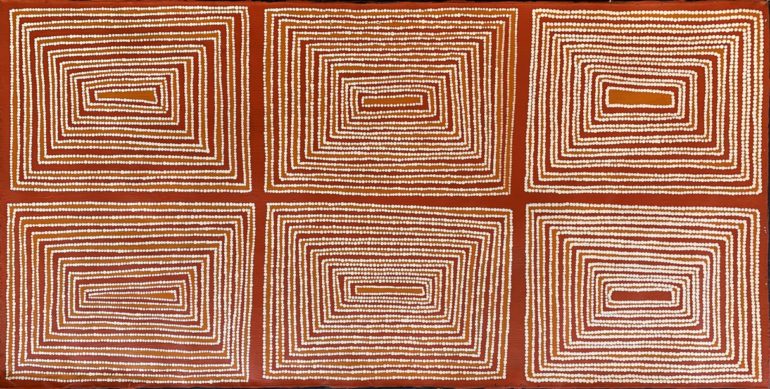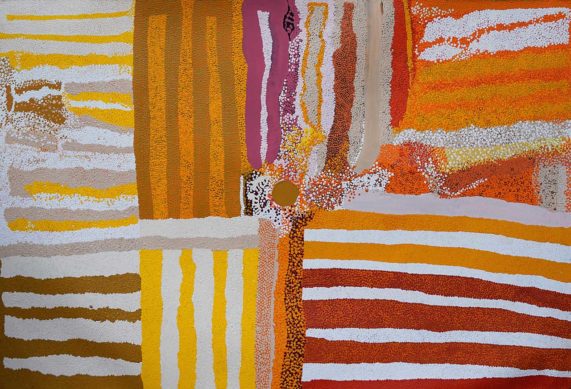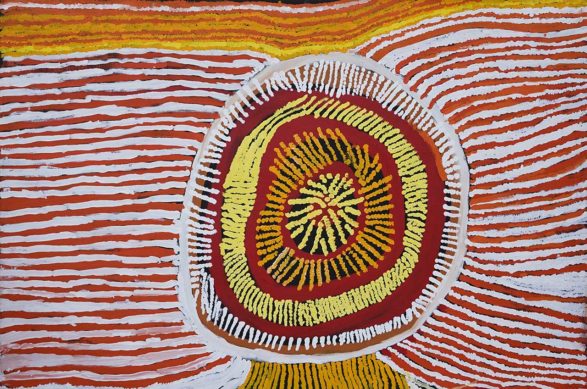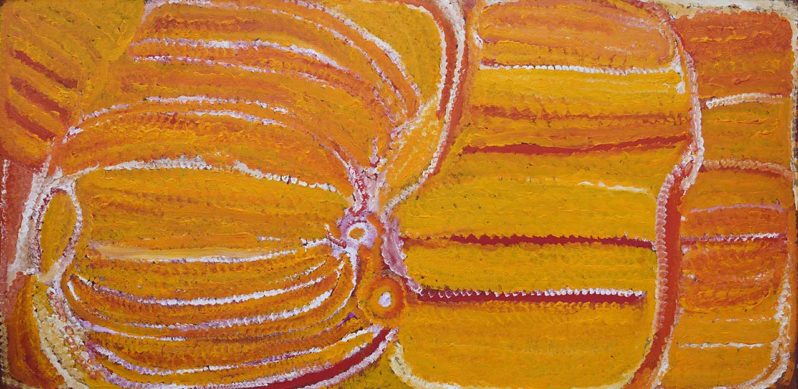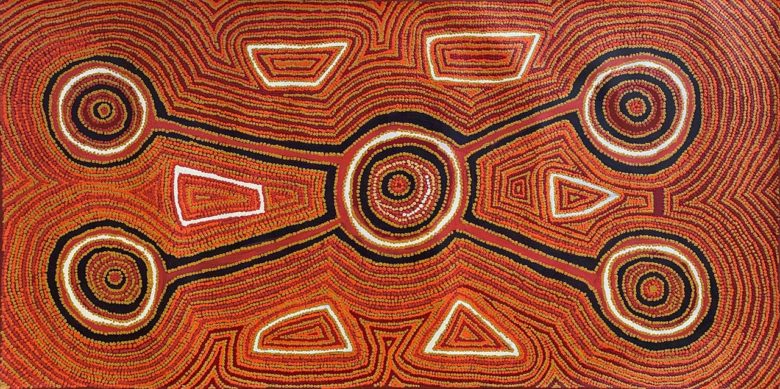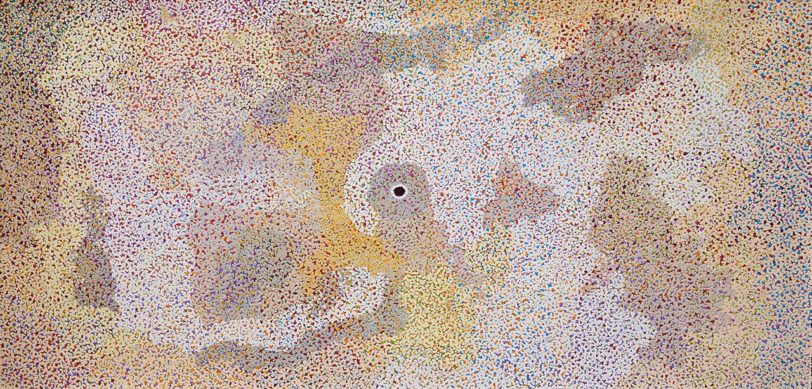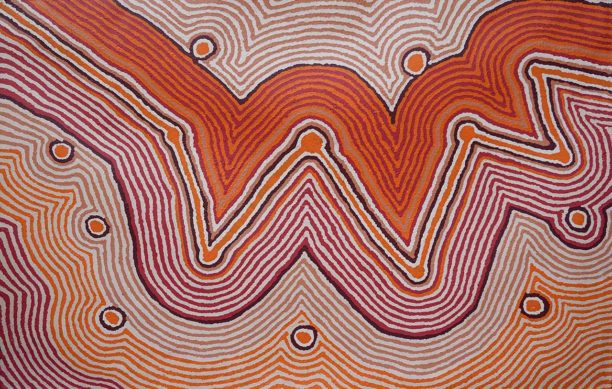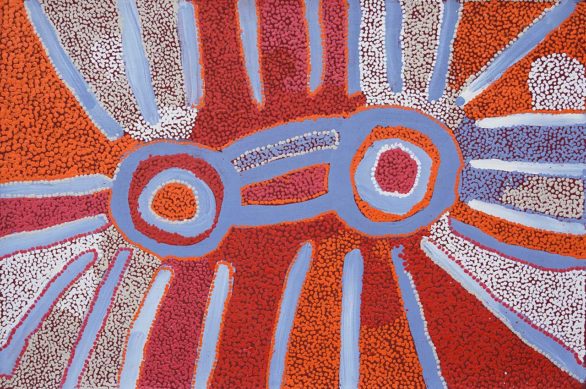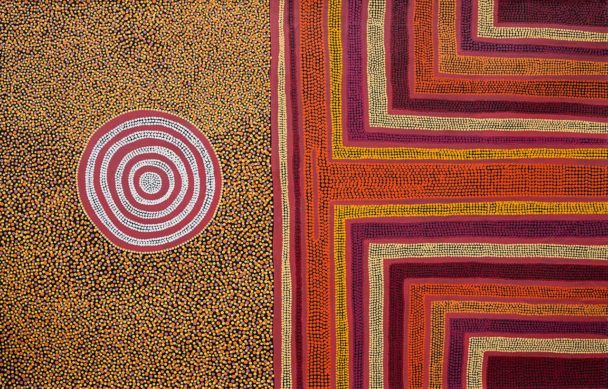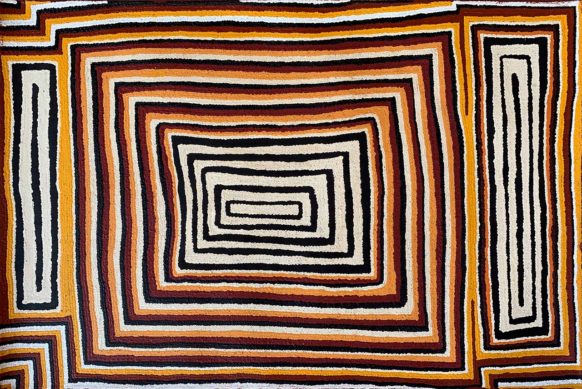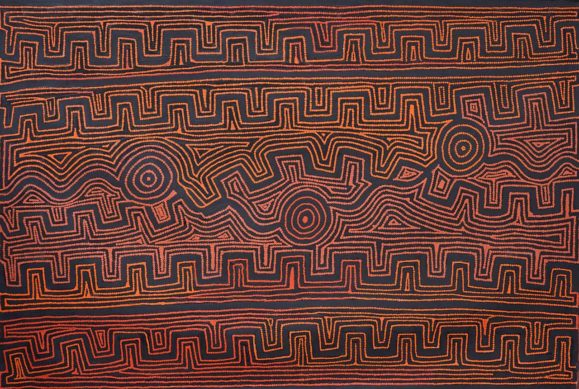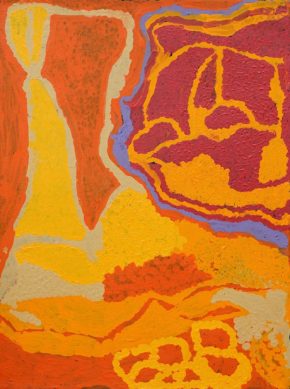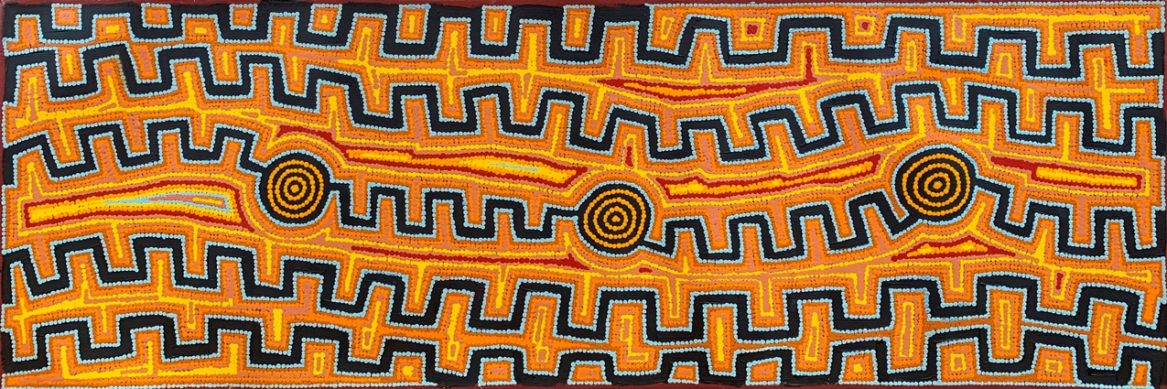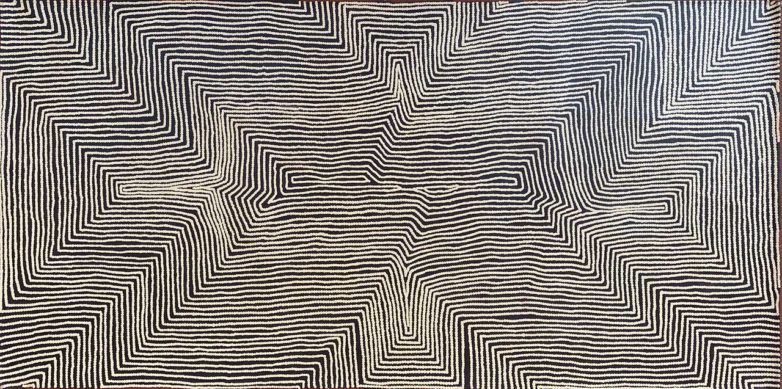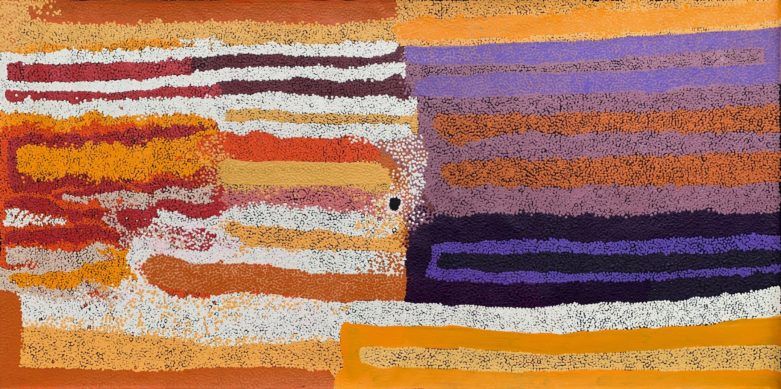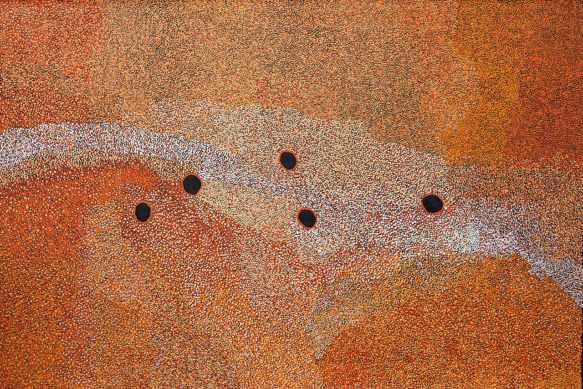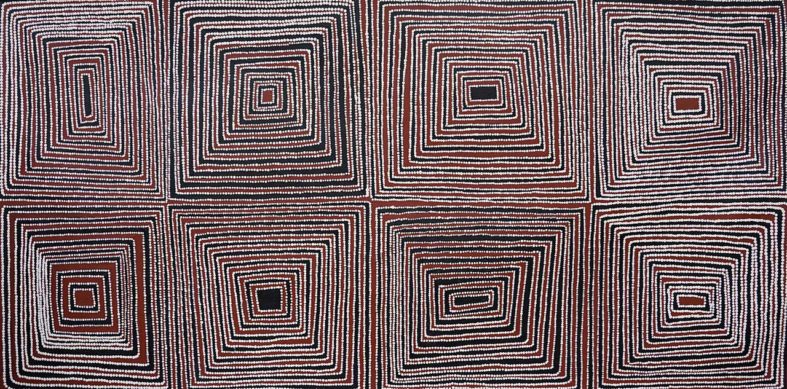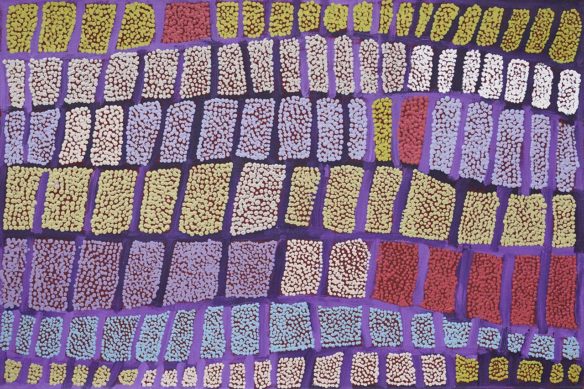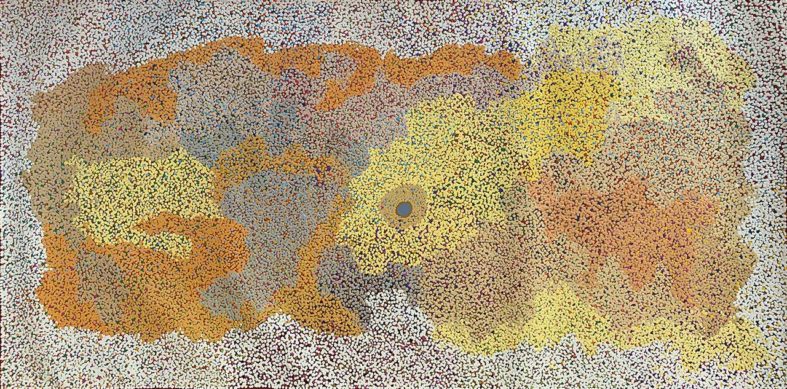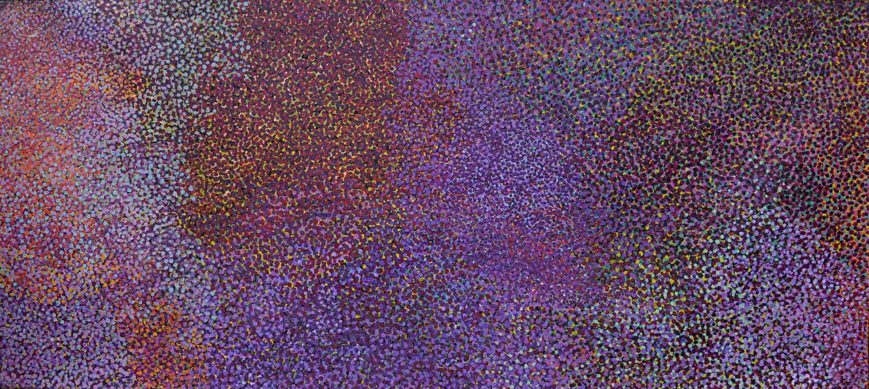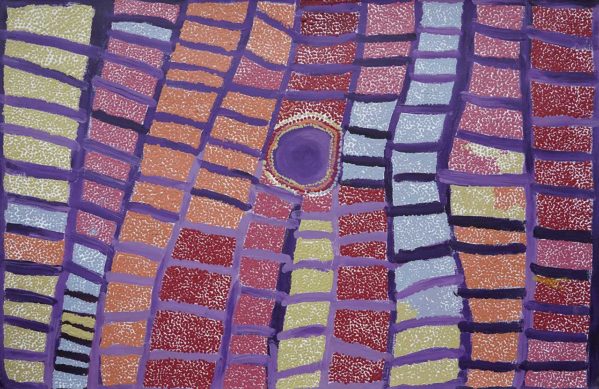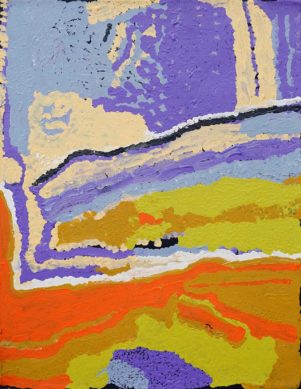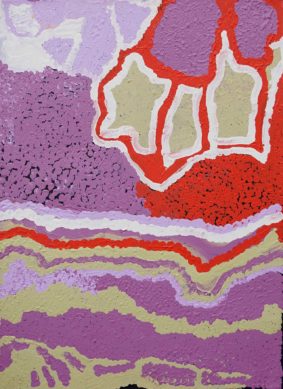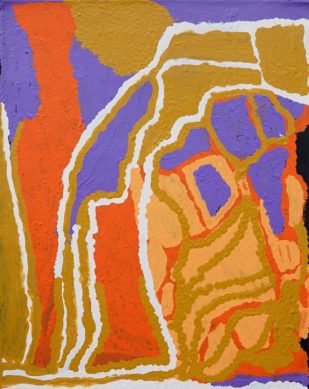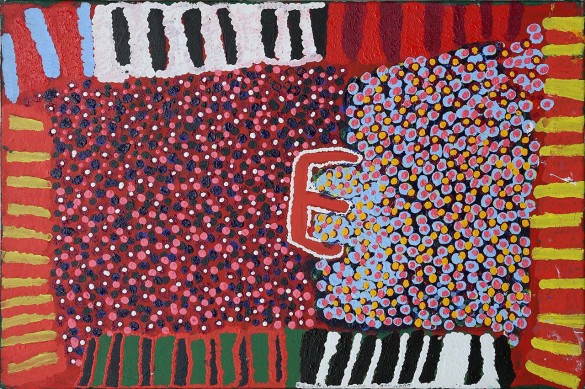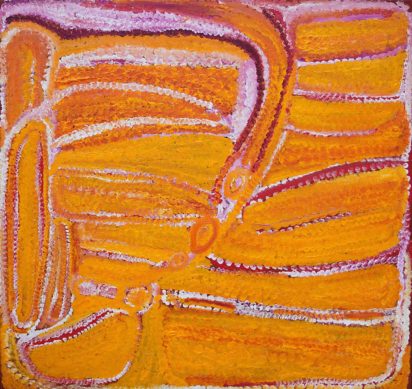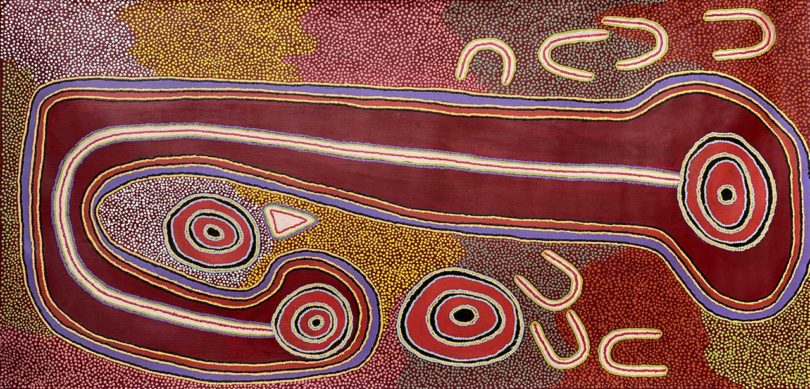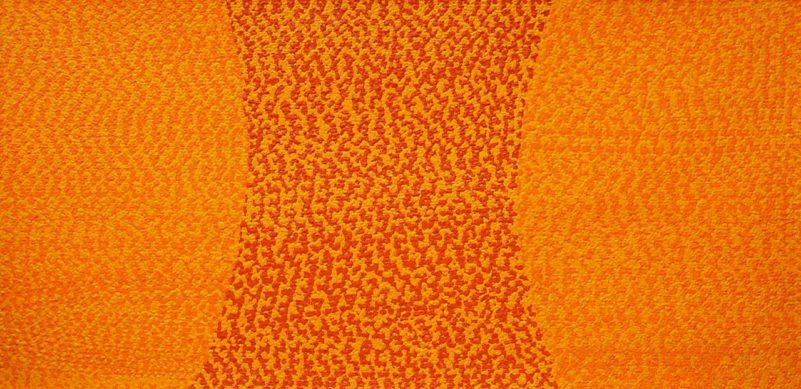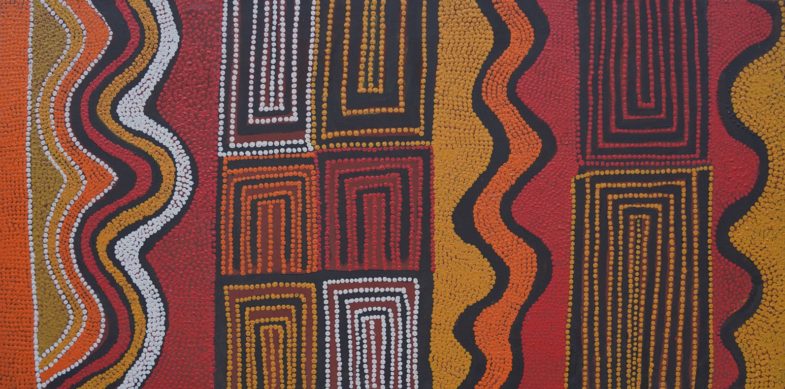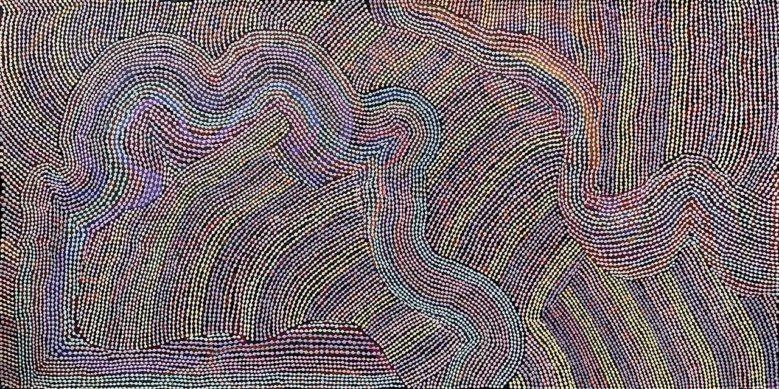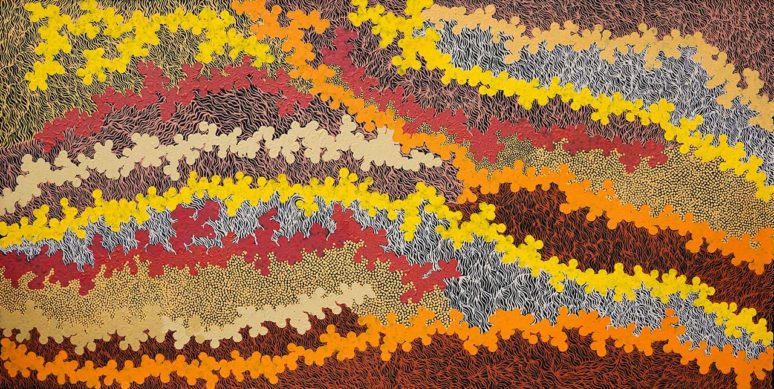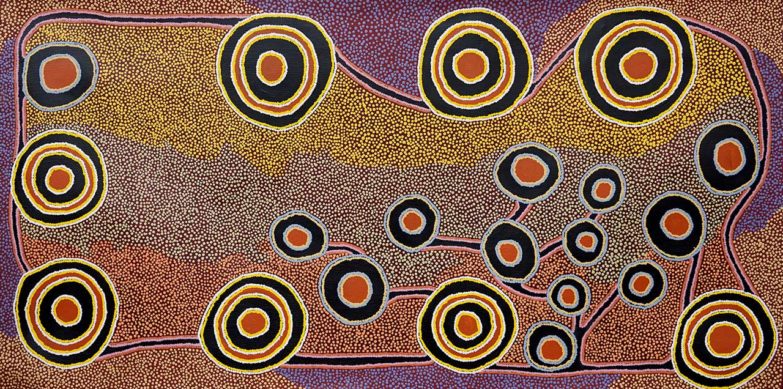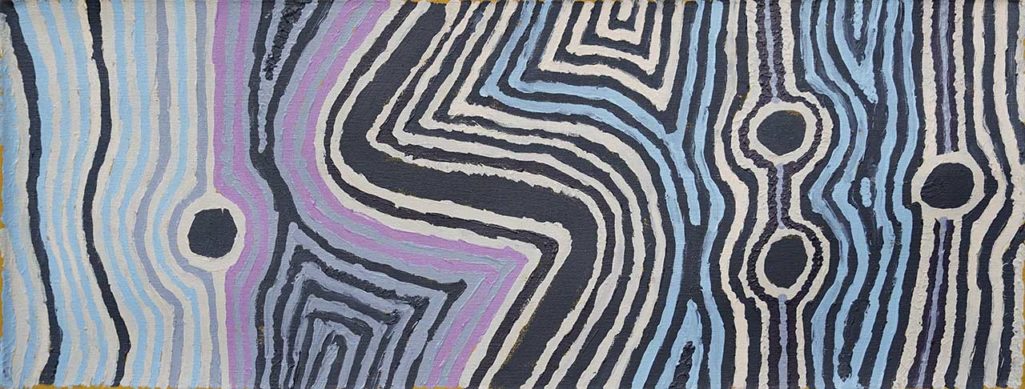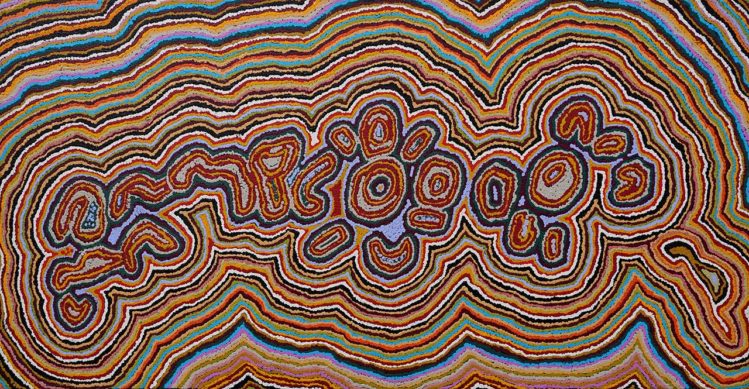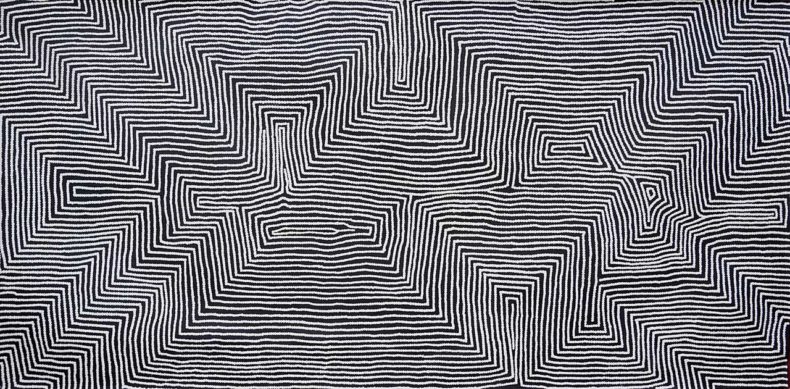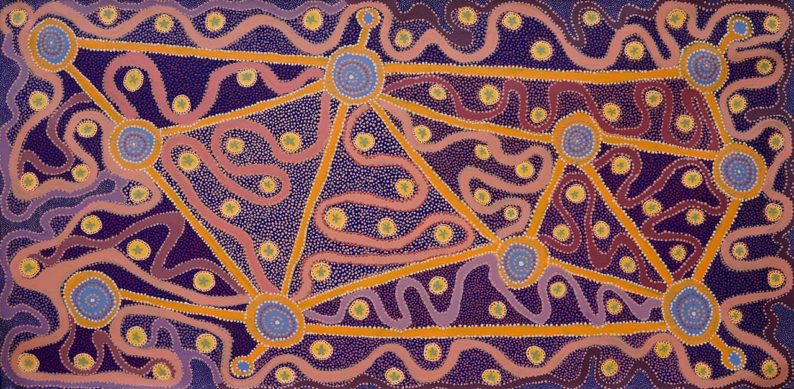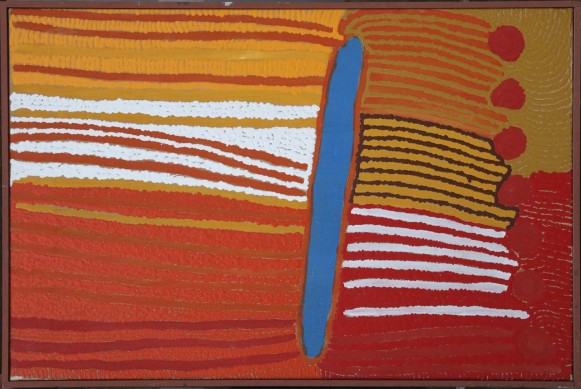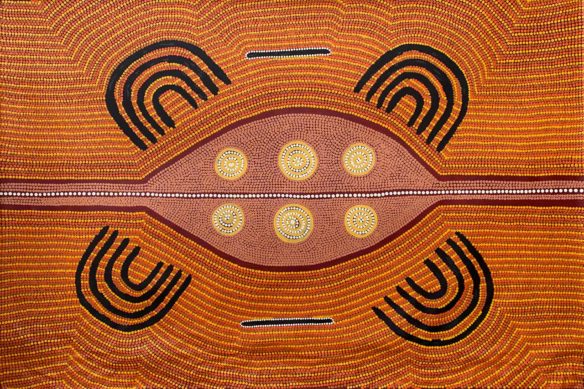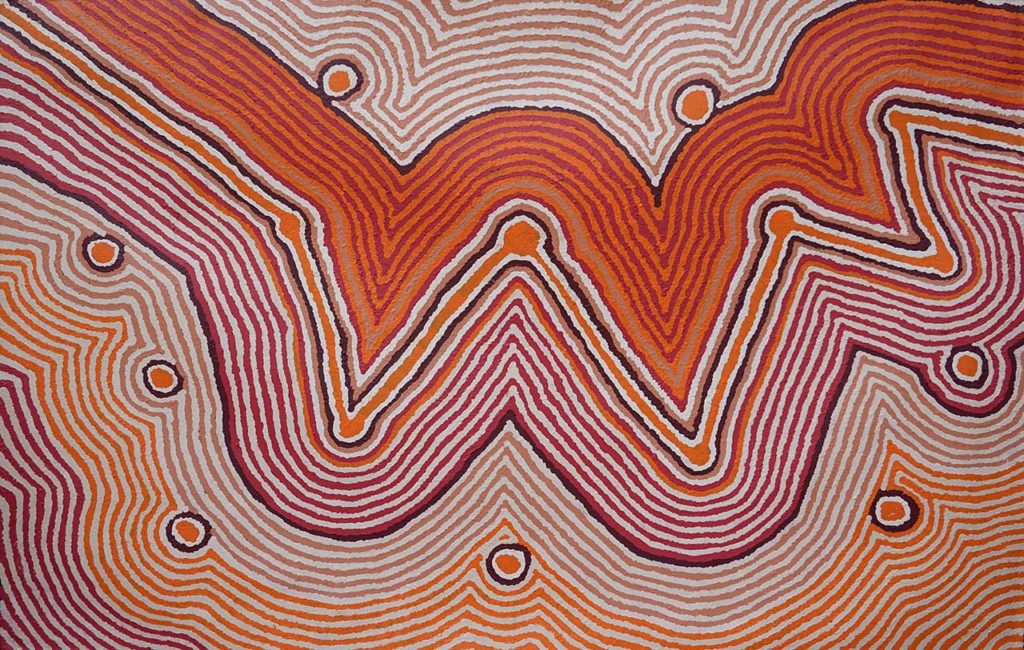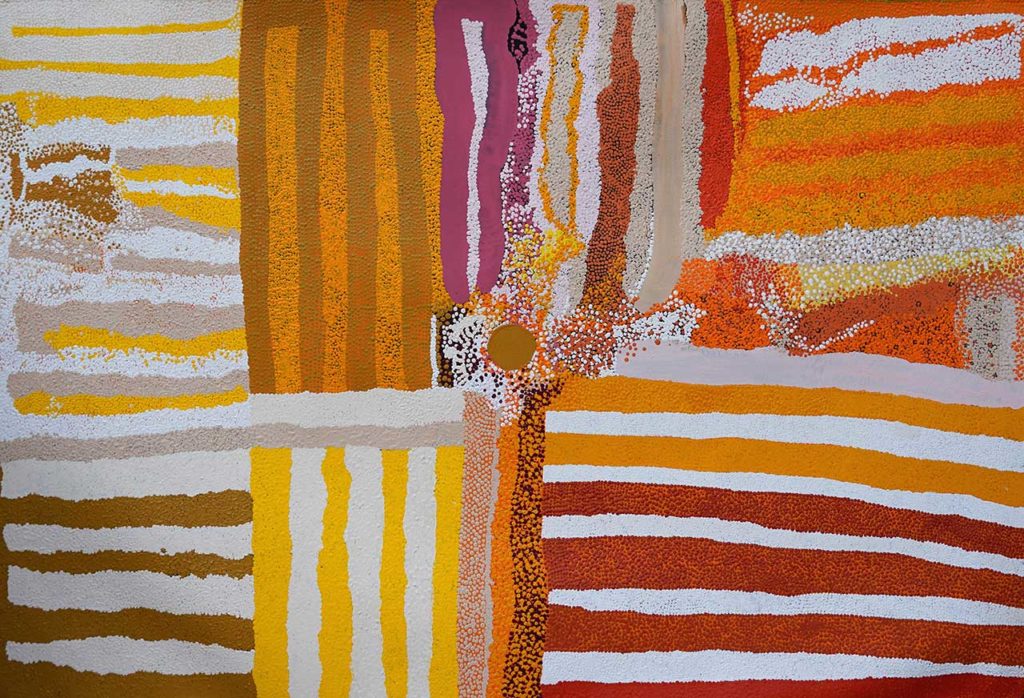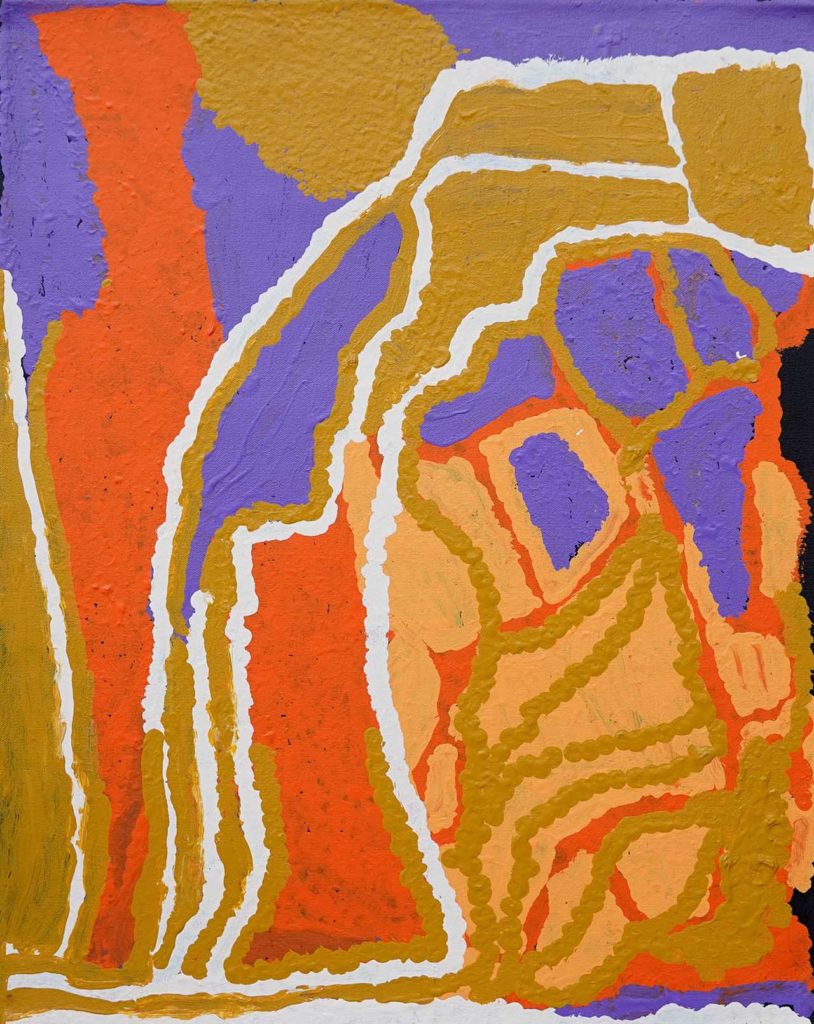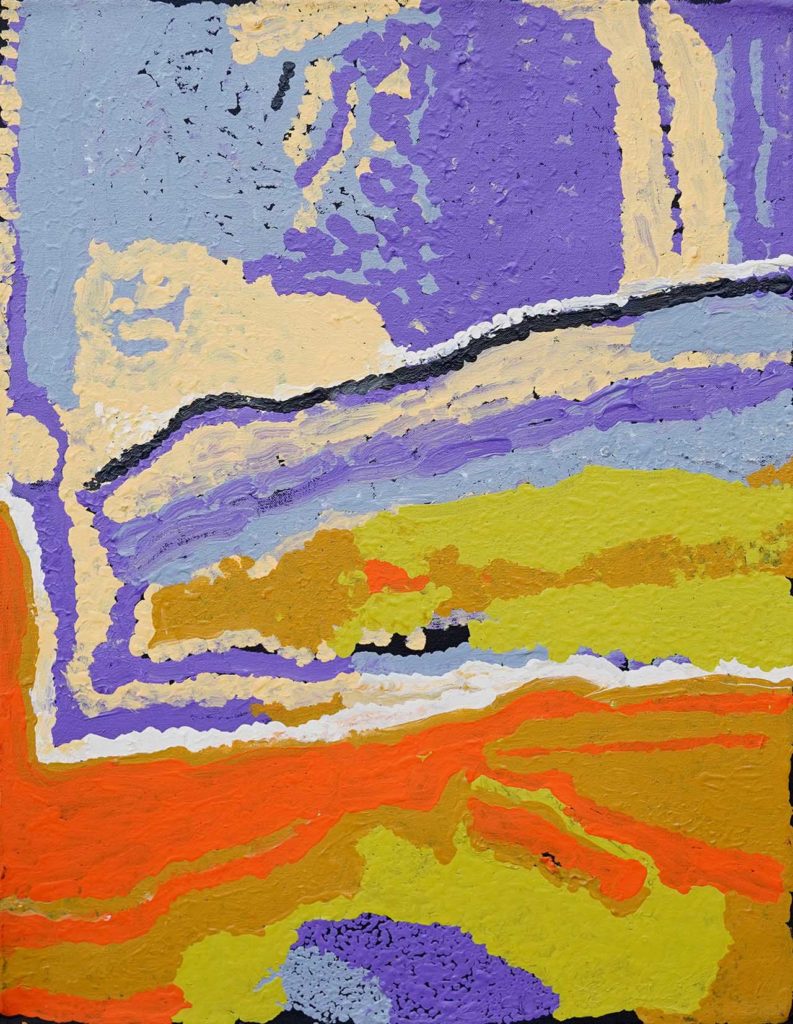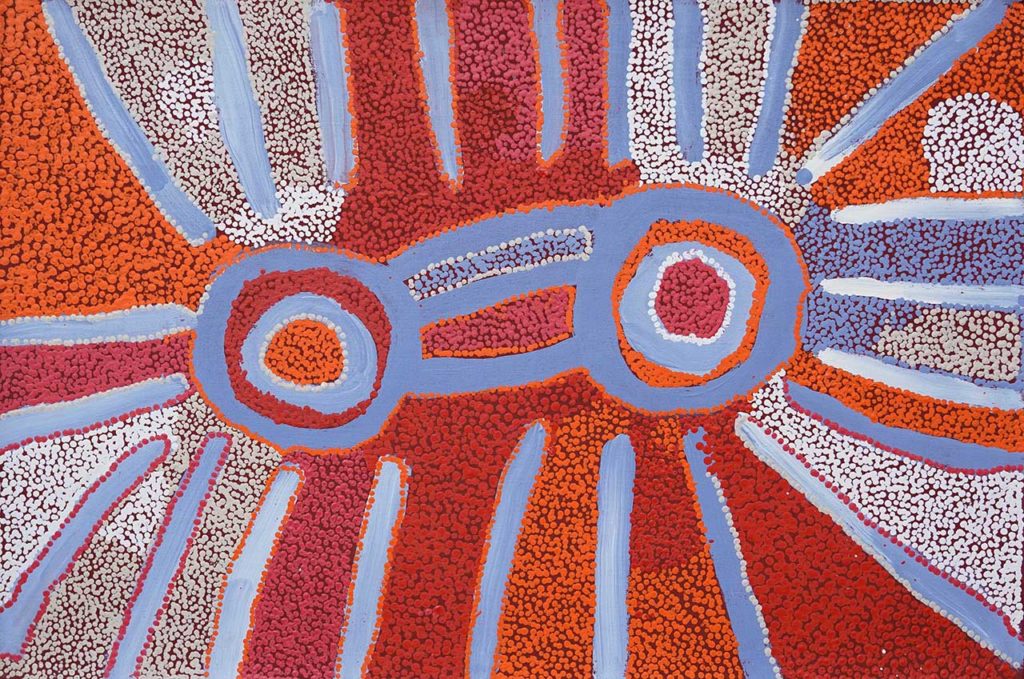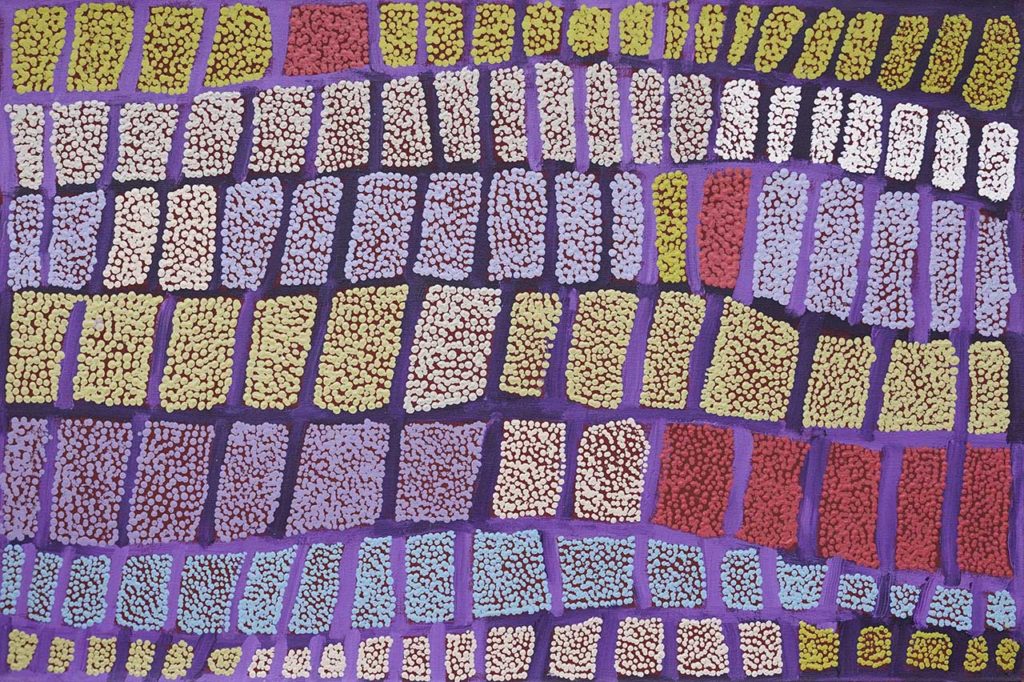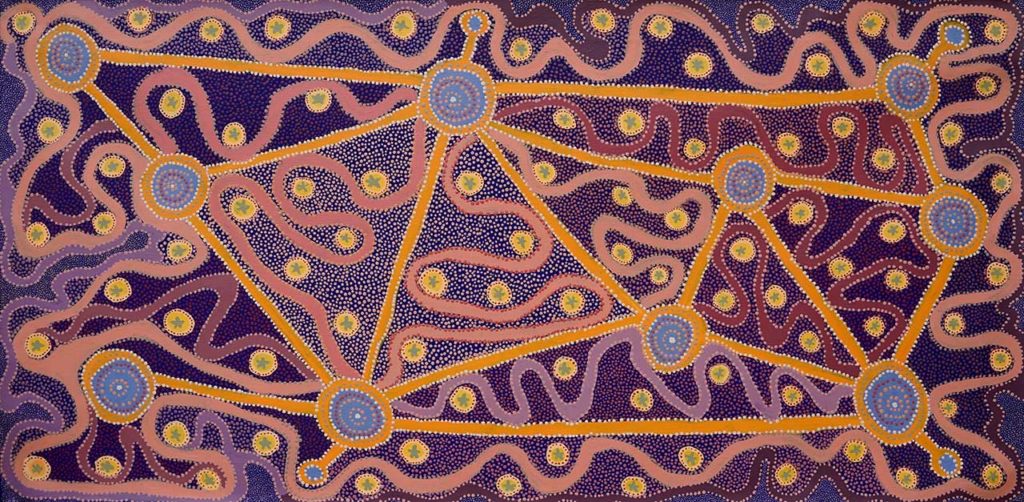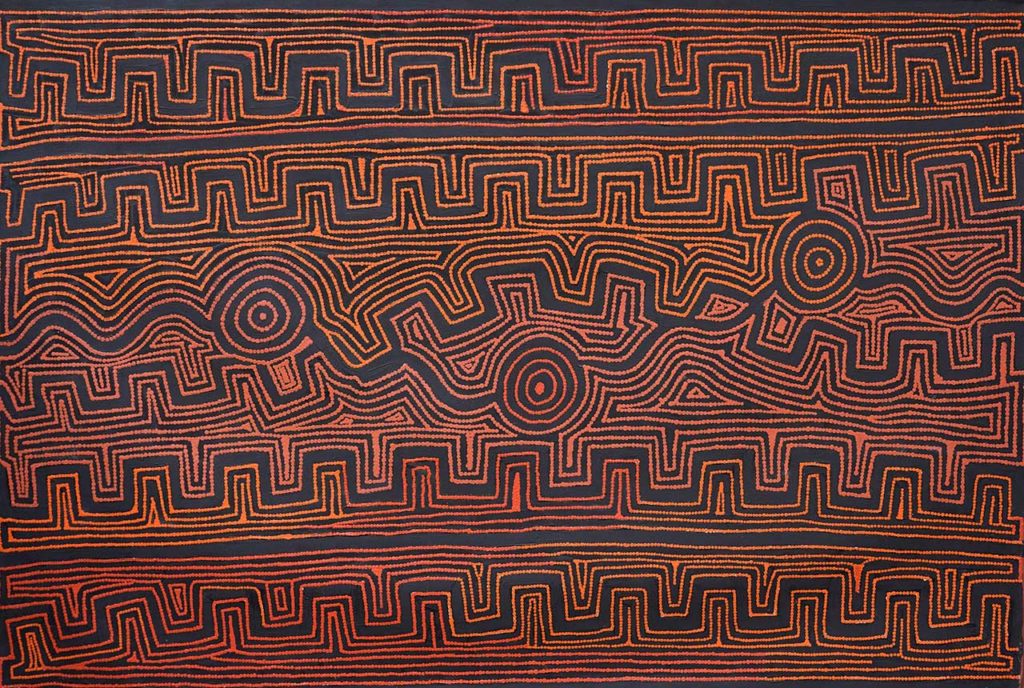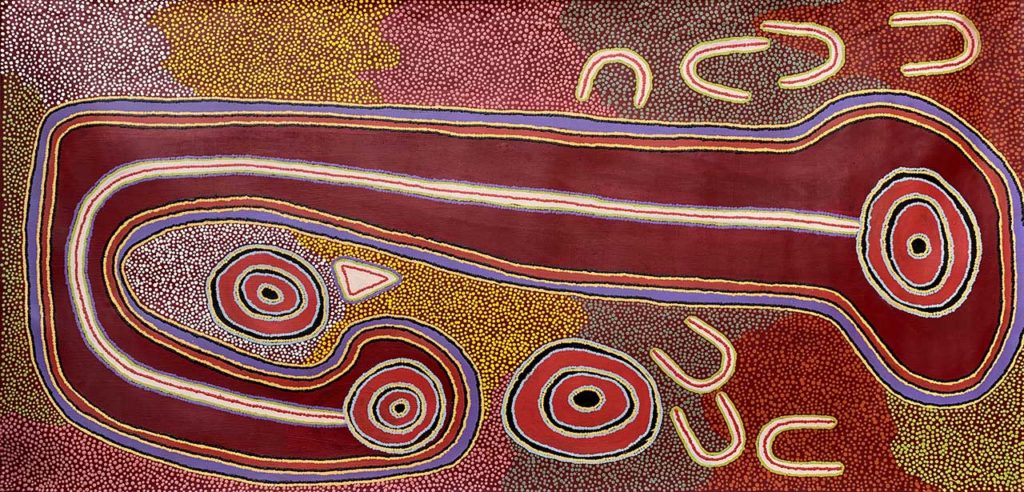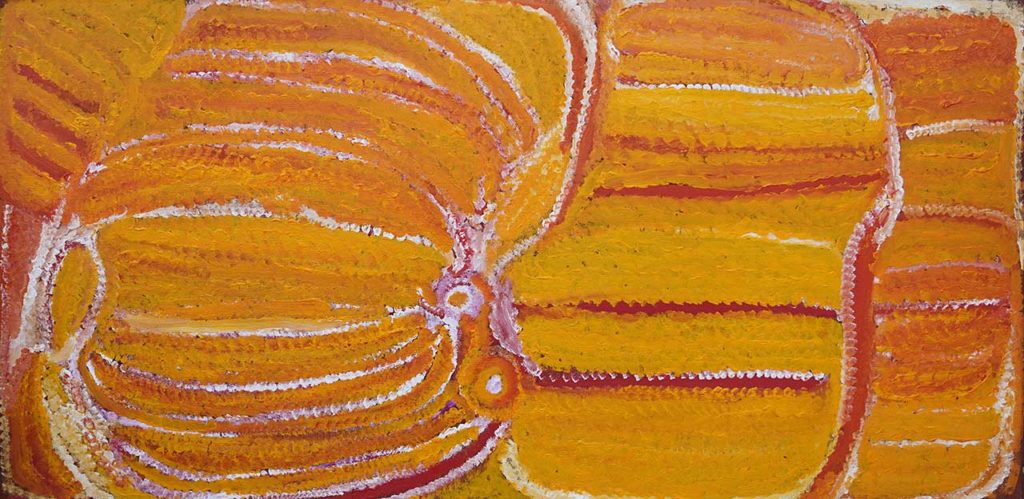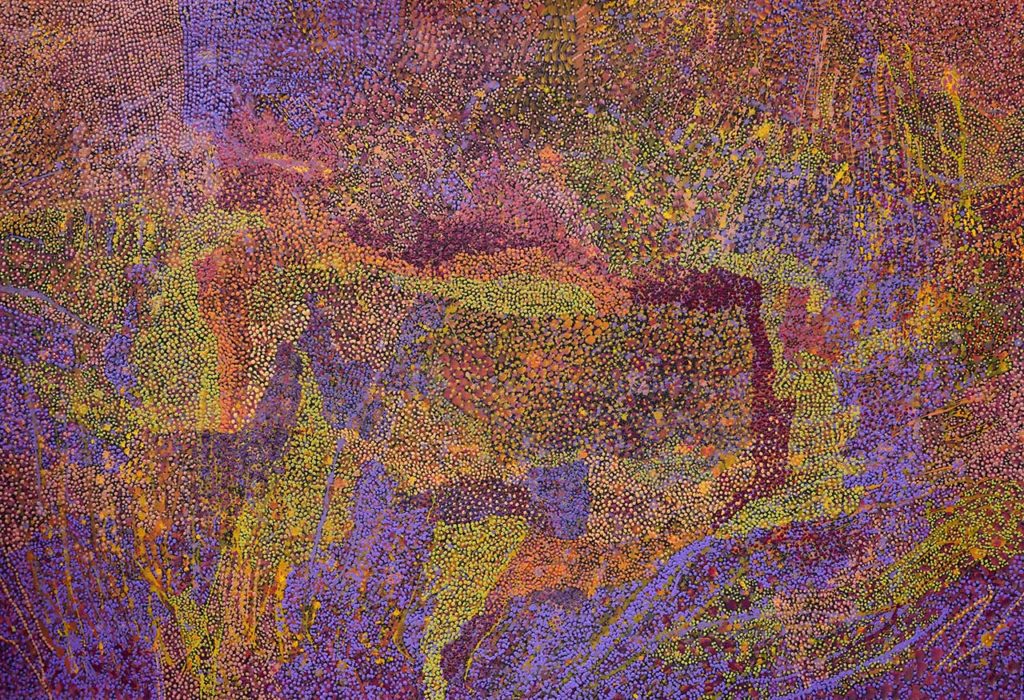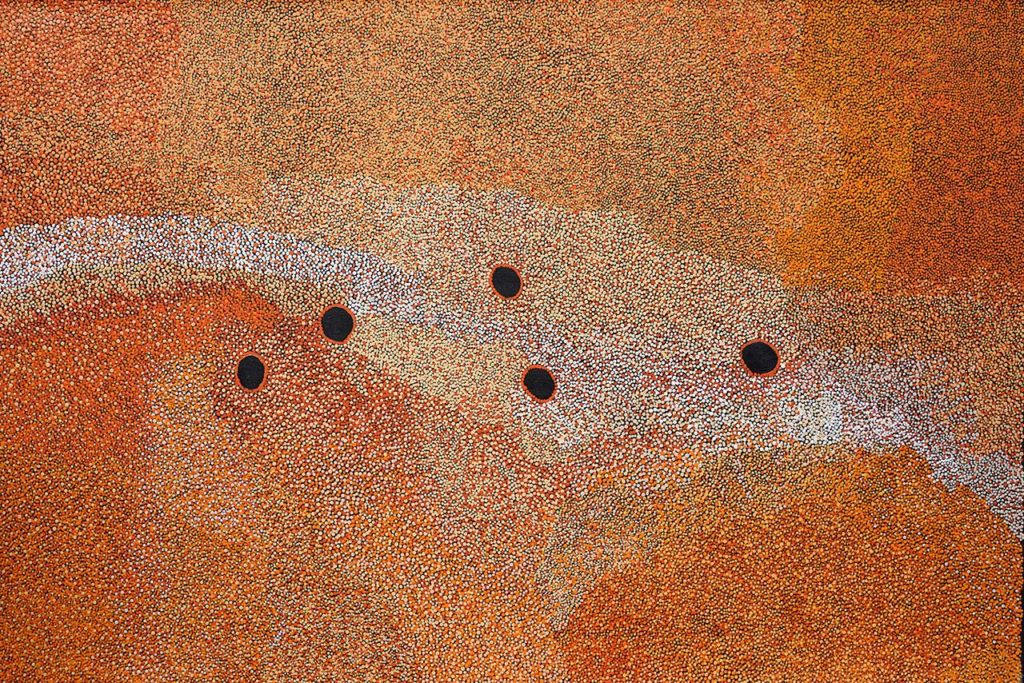Wirrimanu Balgo Artists
Gallery 1
1 November – 20 December 2019
Balgo artists from Warlayirti exhibited at Japingka Gallery in 1999 to celebrate the opening of the new art centre which was recently completed in the community. Dancers, singers, elders and artists attended the event and performed part of the ceremony for the Luurnpa Kingfisher Dreaming story that crosses through the location of the art centre.
Warlayirti Artists has been operating since 1987, one of the first desert art centres to open in Western Australia. This followed the successful exhibition of Balgo artists at the Art Gallery of Western Australia, ‘Art from the Great Sandy Desert’, which had been organised by anthrpologists Ronald and Catherine Berndt and curated by Michael O’Ferrall. The art and culture centre successfully serves 200 Aboriginal artists from Wirrimanu (Balgo), Mulan and Kururrrungku (Billiluna).
Balgo has established a distinctive style of desert artwork, being amongst the first group of desert artists to embrace a broad palette of colours. Its leading artists over the years have included Eubena Nampitjin, Susie Bootja Bootja, Lucy Yukenbarri, Bai Bai Napangati, Helicopter Tjungurrayi, Boxer Milner, Sunfly Tjampitjin and Brandy Tjungurrayi amongst many others. The artists come from a wide range of desert language groups including Kukatja, Warlpiri, Walmajarri, Wangkatjungka, Pintupi and Ngardi.
This exhibition ‘Wirrimanu Balgo Artists’ celebrates the ongoing works of Warlayirti Artists 20 years on from the memorable celebrations that marked the opening of their prestigious art centre. The exhibition runs throughout November and December at Japingka.
Exhibition Walk Through
It is truly exciting to have paintings by the Balgo artists hanging on the walls at Japingka Gallery right now. We’re remembering and celebrating an event we had twenty years ago, when eight artists came down from Balgo for an exhibition at Japingka. The art center had just opened in the community. It was a huge event. It was life-changing for the artists and the whole community. Twenty years down the line, we are here with mostly a new generation of artists. In those twenty years, a lot has changed for the Balgo arts centre.
This is the first survey exhibition by Balgo artists in five years, and the works show the new generation coming through. We’ve also included some historical works by famous artists from the community. Of the senior living artists, Helicopter Tjungurrayi would be one of the best-known Balgo artists. There are also works by Lucy Loomoo and Ningie Nangala. These two women are in their eighties and Helicopter is in his seventies. They are elders still painting in the community, and they are still leading the way.
Their works are classic Balgo pieces in the sense that they are boldly patterned images of desert homelands and significant waterholes from their ancestral country. These paintings are dominated by strong structure and composition. The colours are quite rich, and it’s notable that Balgo was one of the very first communities to embrace full, intense colour into their artistic works.
So we started in the early 1990s to see these intense reds, yellows and oranges begin to emerge. And that was, in many respects, a reaction to the more restrained Pintupi style from painters just across the West Australian border, from Kiwirrkura in Western Australia and Kintore in Northern Territory. So the Balgo artists moved from a very earthy palette to a more intense colour palette, and this still reflected by the artists in the show that have today.
So in many respects these artists are the children and the grandchildren of those inaugurating artists that put Balgo art centre on the map. It’s an extraordinary location because it’s isolated in the sense that it’s about 240 kilometres from the nearest Kimberley town of Halls Creek. And it is in the Tanami Desert, at the top end of the Canning Stock Route. Most of these artists are from families, and a few who are still living, who walked in from the desert following the Canning Stock Route, which was a track that took desert people north.
The end of the track was the mission at Balgo Hills. As that community has become an independently managed settlement for Indigenous people, it still has a very strong record of its history, and perhaps most extraordinary is that there are so many language groups in this community. There may be as many as eight or nine different desert language groups all living in the one settlement, which is quite extraordinary. But over the 60 or 70 years that people have lived there, they have established a cultural understanding, maybe a cultural contract between all the desert language groups. The artists come together at the art centre. We get an extraordinary variety of different styles from different clan groups and different language groups that have settled in the community.
Helicopter’s painting is a wonderful abstract, jagged, linear structure that is all about the nature of mapping desert country. There’s the sandhills and the tracks that lead between the significant water holes. This is part of that conceptual map-making that is so powerful in desert people.
Hanging next to Helicopter’s painting is a painting by Christine Yukenbarri. Christine is the daughter of major artists, and she is probably reflective of where the community goes in terms of its artistic recognition. Already a highly prized artist, with beautifully executed paintings of desert country, these works hark back to her grandmother’s country. In her works of ancestral country are major markings showing sandhills and then very fine dotting indicating country and the the kind of native plants and food sources that are located there.
One of the very senior artists, Ningie Nangala, has a series of small paintings showing her desert country. They’re strong colours and they have the sense that it’s a mind structure, a piece of map making that shows the terrain of the particular part of country that belongs to Ningie’s family. And as a set they’re like beautiful little windows onto the desert landscape and onto her particular family country.
Nearby are Lucy Loomoo’s paintings. Lucy is a senior artist also in her eighties. And Lucy like Ningie Nangala has this really strong structural map making. One extraordinary painting shows two waterholes. And as with some other classic desert paintings the sandhills feed into the cenral image to create a little oasis in the desert. This is a tiny source of water that people have nurtured and kept. But all the lines, the sandhills that feed in towards those two elemental waterholes, highlight the source of survival on desert country for Lucy Loomoo when she was a child.
There is another work by Lucy and it is a classic example of sandhill country – the idea of little protected areas of vegetation that grow in between the parallel rows of sandhills. So this desert sandhill country is not so much random as highly structured, and the sandhills form in the direction of the prevailing winds and have formed tall, parallel barriers that can be 10 or 15 metres high. In between the sandhills there are microclimates and microcosms of the environment, so little areas that may be very barren and some areas that are productive and very green. The artists are people who understand their country. They understand the little pockets of environment that grow in between the sandhills that creates all sorts of opportunities for food-bearing plants to nurture and grow in an otherwise hostile environment.
Miriam Baadjo is a younger generation artist. She has used a more structured approach to showing country. Miriam has very significant artists connections through her family. It shows the structural connections between the waterholes, the travelling paths and the patterns of sandhills and terrain around that country. So, an example of map making that becomes an amazing geometric painting with a meandering feel to it. It’s quite different to anything else in the exhibition.
For real contrast, there are three very geometric paintings that we would probably more closely associate in the style of Pintupi art from Papunya Tula. The first painting we are looking at by Vincent Nangala, is a black and white work. It uses the idea that country is formed by the terrain of sandhills, but those designs then become very much geometric patterns or almost brand markings. People use these to describe their country and then it gets transformed into carving designs that we have seen over the century being put on shields and other artifacts from Aboriginal culture.
So the design has found its way, not in any fixed or prescribed form, but has that extraordinary visual intensity of country that has all these interlocking sandhills. As an optical phenomenon, it’s like standing back from the country and seeing the extraordinary way it all fits together in a geometric sequence. If you can take a distant enough perspective, perhaps as we see it when flying over country now, we can understand the reasoning behind it. But we remember that this is a very traditional pattern that people have been using as part of culture for a very long time.
The whole optical spectacle of this painting, where it’s almost impossible for your eyes to settle on any area as you get drawn around, could easily be conceived as the shifting sands of the desert, the whole difficulty of getting any hard and fast landmarks in a country that shimmers and the sands drift. It gives a sense of country that probably exists in the mind in a much more structured way than it does anywhere visually in the landscape.
The other really powerful geometric painting comes from Matthew West. Matthew has very strong connections into Kintore and Kiwirrkura artists, and his work combines elements that remind us of the work of the great Patrick Tjungurrayi, where we have the waterholes and the Dreaming tracks going through Ancestral country. The design is made up of geometric structures that consist of parallel lines, concentric circles and a meandering track that is a series of three-sided squares forming into a continuous line. I think these are largely used to indicate ancestral tracks, that are something built into the conceptual landscape for Indigenous people. Matthew West has used tones of orange and brown against a black linear structure to create this geometric painting of Country.
Pauline Sunfly is a younger artist who comes from a very famous art family in the community. In this work she depicts the huge salt lake, Lake Mackay, which sits on the outer areas of country where these desert artists have come from. Lake Mackay is an enormous salt lake with various freshwater sources around it. Desert people are able to mark and remember places where fresh water is available below the surface of salt lakes. It gets caught in pockets in the terrain and then they become sources of fresh water in the midst of massive kilometres of salt lakes that spread as far as the horizon. So in this painting, Pauline has marked some major sites along that salt lake country.
Eubena Nampitjin is one of the most significant artists ever to paint at Balgo. She passed away in 2013 and her works are part of the high point of recognition for the artistic output from Balgo artists. These classic works from her, show the waterholes and the country in luminous yellow and gold, red and orange structures. The desert sandhills are there as are the waterholes. The work is made up of dot work, you could say painted with the thick end of a round brush and then dragged to make the whole surface one continuous merger of colour. There are variations with every brushstroke as the dots are applied and then dragged into the next dot. Eubena’s work is highly distinctive and very beautiful – classic desert art representation and one of the highlights from Balgo arts.
Patsy Mudgedell is also the current generation of exciting artists out of Balgo. Her work shows the vast expanse of Country, finely dotted with subtle variations in the blocks of colour as we stand in front of a painting that has purples, oranges, greens and golden yellows in it. Patsy paints aspects of traditional country, but also takes on her own experiences about life lived in the community to create other types of subjects. She can be a very contemporary looking painter. She uses a full range of colours in her paintings and is also a wonderful spokesperson for the current generation of artists and producers. Quite extraordinary works.
The other major current artist in this exhibition is Imelda (Yukenbarri) Guguman. Her wonderful paintings are very finally dotted with the structural elements embedded right into the dot work. There’s a merging of her tonal colours using all the earthy yellows and oranges of desert country. It depicts certain waterholes as you move across country. These works are delicately painted and beautifully resolved in terms of the colours, and the whole effect is very subtle.
We now have three generations of artists from this family, and Imelda’s very senior works express a different, a less raw look at country than what we had when the artists established the credentials of Balgo art, say 20 or 25 years ago. This is another generation finding ways to move forward and express art about a country that is deeply connected to all generations of their family.

